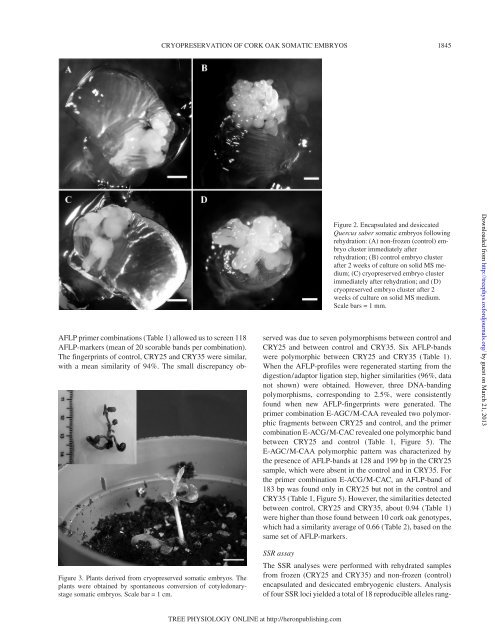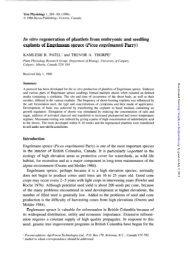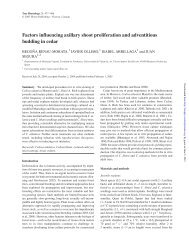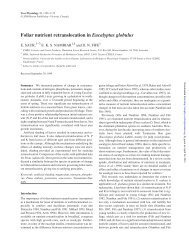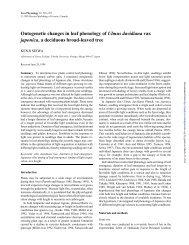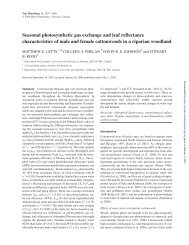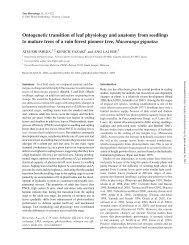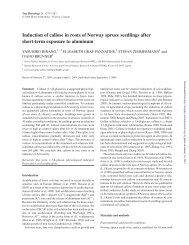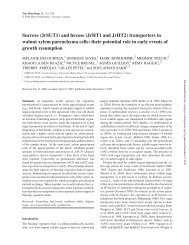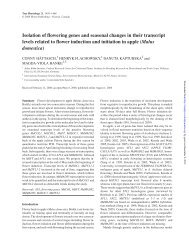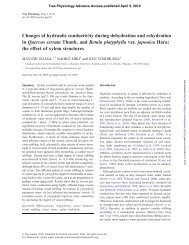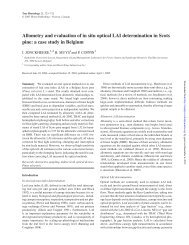Cryopreservation of Quercus suber somatic embryos - Tree Physiology
Cryopreservation of Quercus suber somatic embryos - Tree Physiology
Cryopreservation of Quercus suber somatic embryos - Tree Physiology
You also want an ePaper? Increase the reach of your titles
YUMPU automatically turns print PDFs into web optimized ePapers that Google loves.
AFLP primer combinations (Table 1) allowed us to screen 118<br />
AFLP-markers (mean <strong>of</strong> 20 scorable bands per combination).<br />
The fingerprints <strong>of</strong> control, CRY25 and CRY35 were similar,<br />
with a mean similarity <strong>of</strong> 94%. The small discrepancy ob-<br />
Figure 3. Plants derived from cryopreserved <strong>somatic</strong> <strong>embryos</strong>. The<br />
plants were obtained by spontaneous conversion <strong>of</strong> cotyledonarystage<br />
<strong>somatic</strong> <strong>embryos</strong>. Scale bar = 1 cm.<br />
CRYOPRESERVATION OF CORK OAK SOMATIC EMBRYOS 1845<br />
TREE PHYSIOLOGY ONLINE at http://heronpublishing.com<br />
Figure 2. Encapsulated and desiccated<br />
<strong>Quercus</strong> <strong>suber</strong> <strong>somatic</strong> <strong>embryos</strong> following<br />
rehydration: (A) non-frozen (control) embryo<br />
cluster immediately after<br />
rehydration; (B) control embryo cluster<br />
after 2 weeks <strong>of</strong> culture on solid MS medium;<br />
(C) cryopreserved embryo cluster<br />
immediately after rehydration; and (D)<br />
cryopreserved embryo cluster after 2<br />
weeks <strong>of</strong> culture on solid MS medium.<br />
Scale bars = 1 mm.<br />
served was due to seven polymorphisms between control and<br />
CRY25 and between control and CRY35. Six AFLP-bands<br />
were polymorphic between CRY25 and CRY35 (Table 1).<br />
When the AFLP-pr<strong>of</strong>iles were regenerated starting from the<br />
digestion/adaptor ligation step, higher similarities (96%, data<br />
not shown) were obtained. However, three DNA-banding<br />
polymorphisms, corresponding to 2.5%, were consistently<br />
found when new AFLP-fingerprints were generated. The<br />
primer combination E-AGC/M-CAA revealed two polymorphic<br />
fragments between CRY25 and control, and the primer<br />
combination E-ACG/M-CAC revealed one polymorphic band<br />
between CRY25 and control (Table 1, Figure 5). The<br />
E-AGC/M-CAA polymorphic pattern was characterized by<br />
the presence <strong>of</strong> AFLP-bands at 128 and 199 bp in the CRY25<br />
sample, which were absent in the control and in CRY35. For<br />
the primer combination E-ACG/M-CAC, an AFLP-band <strong>of</strong><br />
183 bp was found only in CRY25 but not in the control and<br />
CRY35 (Table 1, Figure 5). However, the similarities detected<br />
between control, CRY25 and CRY35, about 0.94 (Table 1)<br />
were higher than those found between 10 cork oak genotypes,<br />
which had a similarity average <strong>of</strong> 0.66 (Table 2), based on the<br />
same set <strong>of</strong> AFLP-markers.<br />
SSR assay<br />
The SSR analyses were performed with rehydrated samples<br />
from frozen (CRY25 and CRY35) and non-frozen (control)<br />
encapsulated and desiccated embryogenic clusters. Analysis<br />
<strong>of</strong> four SSR loci yielded a total <strong>of</strong> 18 reproducible alleles rang-<br />
Downloaded from<br />
http://treephys.oxfordjournals.org/ by guest on March 21, 2013


